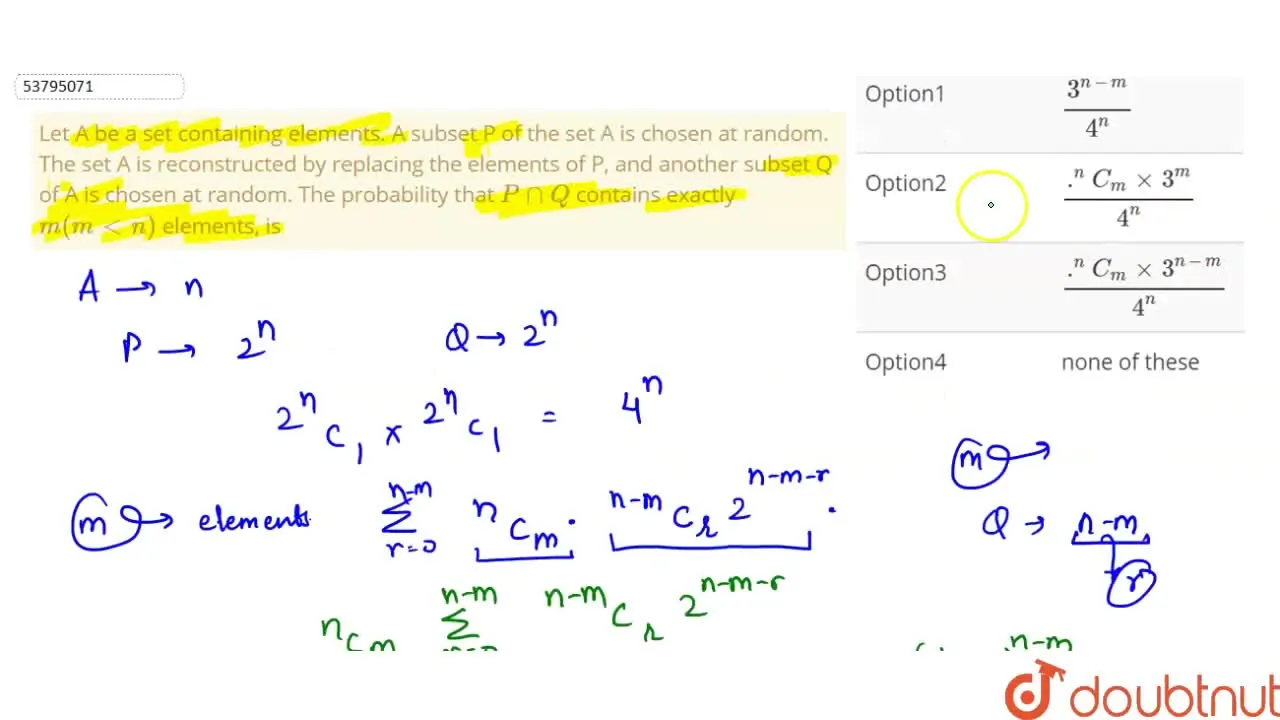Let A be a set containing elements. A subset P of the set A is chosen at random. The set A is reconstructed by replacing the elements of P, and another subset Q of A is chosen at random. The probability that P∩Q contains exactly m(m<n) elements, is
3n−m4n
.nCm×3m4n
.nCm×3n−m4n
none of these
The correct Answer is:C
We know that the number of subsets of a set containing n elements is 2n. Therefore, the number of subsets of a set containing n elements is 2n. Therefore, the number of ways of choosing P and Q is .2nC1×.2nC1=2n×2n=4n.
Out of n elements, m elements can be chosen in .nCm ways. If P∩Q contains exactly m elements, then from the remaining n-m elements either an element belongs to P or Q but not both P and Q. Suppose P contains r elements from the remaining (n-m) elements. Then, Q may contain any number of elements from the remaining (n-m)-r elements. Therefore, P and Q can be chosen in .n−mCr2(n−m)−r
But , r can vary from 0 to (n-m).
So, the number of ways in which P and Q can be chosen, is
{n−m∑r=0.n−mCr2(n−m)−r}.nCm=(1+2)n−m.nCm=.nCm3n−m
Hence, required probability =.nCm×3n−m4n
Related Playlists
- BOOK - OBJECTIVE RD SHARMACHAPTER - PROBABILITY EXERCISE - Section- II (Assertion -Reason Types MCQs)15videos
PROBABILITY
- BOOK - OBJECTIVE RD SHARMACHAPTER - PROBABILITY EXERCISE - Section I - Mcqs94videos
PROBABILITY
- BOOK - OBJECTIVE RD SHARMACHAPTER - PROBABILITY EXERCISE - Chapter Test45videos
PROBABILITY
- BOOK - OBJECTIVE RD SHARMACHAPTER - PERMUTATIONS AND COMBINATIONSEXERCISE - Chapter Test60videos
PERMUTATIONS AND COMBINATIONS
- BOOK - OBJECTIVE RD SHARMACHAPTER - QUADRATIC EXPRESSIONS AND EQUATIONS EXERCISE - Chapter Test50videos
QUADRATIC EXPRESSIONS AND EQUATIONS
Similar Questions
A subset A of the set X={1,2,3,..,100} is chosen at random. The set X is reconstructed by replacing the elements of A, and another subset B of X is chosen at random. The probability that A∩B contains exactly 10 elements, is
View SolutionA is a set containing n elements. A subset P of A is chosen at random. The set A is reconstructed by replacing the elements of P. A subset Q is again chosen at random. The probability that P =Q, is
View SolutionA is a set containing n elements. A subset P of A is chosen at random. The set A is reconstructed by replacing the elements of P. A subset Q is again chosen at random. The Probability that P∩Q contain just one element, is
View SolutionA is a set containing n elements. A subset P of A is chosen at random. The set A is reconstructed by replacing the elements of P. A subset Q is again chosen at random. The Probability that P∪Q contain just one element, is
View SolutionA is a set containing n elements. A subset P of A is chosen at random. The set A is reconstructed by replacing the elements of P. A subset Q is again chosen at random. The Probability that P∪Q=A, is
View SolutionA subset A of the set X={1.2,3.....100} is chosen at random. The set X is reconstructed by replacing the elements of A, and another subset B of X is chosen at random. Then the probability that A∩B contains exactly 10 elements is
View SolutionA is a set containing n elements. A subset P of A is chosen at random. The set A is reconstructed by replacing the elements of P. A subset Q is again chosen at random. The Probability that Q is a subset of P, is
View SolutionA is a set containing n elements. A subset P of A is chosen at random. The set A is reconstructed by replacing the elements of P. A subset Q is again chosen at random. The probability that P and Q are disjoint sets, is
View SolutionA is a set containing n elements. A subset P of A is chosen at random. The set A is reconstructed by replacing the elements of P. A subset Q is again chosen at random. The probability that Q contains just one element more than P, is
View SolutionA is a set containing n elements. A subset P of A is chosen at random. The set A is reconstructed by replacing the elements of P. A subset Q is again chosen at random. The Probability that P and Q have equal number of elements, is
View Solution


